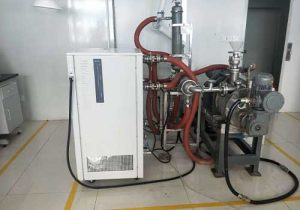How does a 5 ton chiller work?
How does a 5 ton chiller work?
In most cooling applications, the pump system circulates cold water or ethylene glycol solution from the cooler to remove heat. This cold fluid carries away the heat during the process, while the hot fluid returns to the cooler. Process water is a method of transferring heat from the process to the cooler.
The process cooler contains a compound called refrigerant. There are many types of refrigerants and applications based on the required temperature, but they all operate according to the basic principles of compression and phase change of refrigerants from liquid to gas and back to liquid.
The process of heating and cooling the refrigerant, converting it from a gas to a liquid, and then back again, is called a refrigeration cycle.
The refrigeration cycle starts with the low-pressure liquid/gas mixture entering the evaporator. In the evaporator, the heat from process water or water/ethylene glycol solution causes the refrigerant to boil, thereby transforming it from a low-pressure liquid to a low-pressure gas.
Low pressure gas enters the compressor and is compressed into high-pressure gas. The high-pressure liquid flows to the expansion valve, which controls how much liquid refrigerant enters the evaporator and starts the refrigeration cycle again.
There are two types of condensers used in chillers; Air cooled and water cooled. The air-cooled condenser uses ambient air to cool the hot refrigerant gas and condense it back into the liquid. It can be located inside the cooler or outside, but ultimately it releases heat from the cooler into the air. In a water-cooled condenser, water from the cooling tower cools and condenses the refrigerant.
The chiller provides consistent temperature and pressure for your industrial process, eliminating temperature and pressure, simplifying process development and optimization, and improving product quality.
Industrial chillers are not wasteful single channel systems, but circulating cooling water. Recycling minimizes the cost of water consumption, which may be expensive and environmentally unfriendly.
Related recommendations
process cooling water system
610Process cooling water systems are an essential part of many industrial operations, where temperature control is critical for the efficiency and safety of equipment, as well as the quality of produ...
View detailsLow Temperature Chiller Equipment for Hydrogen Production Machine
1767Low Temperature Chiller Equipment for Hydrogen Production Machine In the hydrogen production process of water electrolysis, once the temperature rises uncontrollably, the hydrogen production...
View detailssmall portable water chiller units
375Introduction to Small Portable Water Chiller UnitsSmall portable water chiller units are specialized cooling devices designed to provide efficient cooling in a compact and movable form. Unlike la...
View detailswater cooled chiller working
317The Refrigeration Cycle: Core Working ProcessThe working of a water cooled chiller revolves around the refrigeration cycle, which consists of four sequential stages, each facilitated by key compo...
View details
 LNEYA Chiller
LNEYA Chiller






HelloPlease log in